
So, it was time for another mountain trip. It had been a few years since I’d been last, to the Blue Ridge area in NC, but over fifteen since I’d been to the Lake Rabun area of Georgia. This time around, I was accompanied by The Girlfriend and The Girlfriend’s Sprog, neither of which had been to Lake Rabun. We only had time for a brief trip, but it was enough time to see what we were after. The audio tells the story a bit better.
Walkabout podcast – Yeah, me too
The opening image, by the way, is Looking Glass Falls in Pisgah National Forest, North Carolina, near the town of Brevard – definitely the easiest waterfall to access that I’ve come across. As empty as it seems here, it was actually a busy day down there, and I waited until several people were out of the frame before snapping that one; a couple of minutes later, several more visitors decided to swim in the pool directly underneath the falls, which doesn’t create the ideal shot. I spent a little time chasing frames of opportunity.
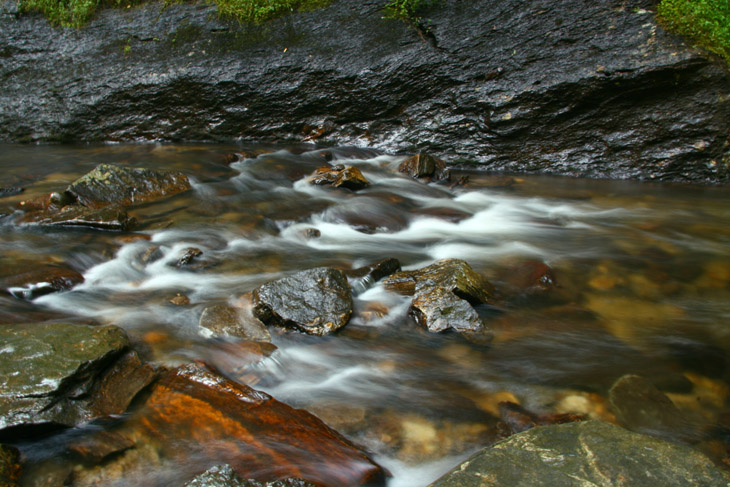
But our key destination was still over an hour south into the mountains of north Georgia, because we had to get into the path of the total solar eclipse. Did you really expect otherwise from me? Well, you could have been wrong, because it wasn’t going to take much to convince me not to bother, for reasons stated within the podcast. I had also been considering meeting up with Jim Kramer (that name may sound familiar,) since he lived very close to the path of totality in Kansas and I’d been looking for an excuse to get out there anyway. But I also considered the possibility that the weather would go bad in any particular location and there would be little or nothing to see, and figured that if we each remained (more or less) in our own areas, we’d double the chance of one of us, at least, getting useful viewing conditions.
Jim, unfortunately, did indeed run into some adverse cloud conditions, though he still got a few worthwhile images:

As you can see, the weather wasn’t quite cooperating where he was.
A quick note here. Jim splurged for a dedicated solar filter intended for photography, an expensive little bit of equipment useful primarily for eclipses and sunspots. I, on the other hand, am a cheap bastard, and I fashioned a solar filter from basic materials, which I also provided to the Indomitable Mr Bugg, who also ran into clouds, right before peak coverage in his area, though he’d gone out to Myrtle Beach where the eclipse wouldn’t be total, just 99%.
But here’s another example from Jim, showing what a dedicated solar filter will do:

Curiously, the edge of the moon is quite sharp, but the edge of the sun has a peculiar effect which I’m putting down to the exposure that Jim used, or possibly clouds. He may come along and correct me.
In contrast, here’s what I was accomplishing with my homemade filter:
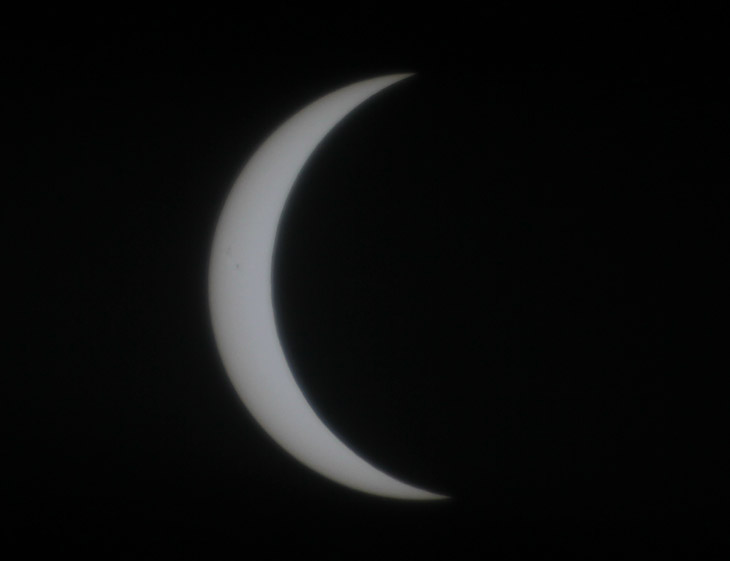
I didn’t really get much edge detail from the moon, but it’s not as bad as I’d feared, and I still captured a couple of sunspots on the sun’s limb. And don’t ask me why astronomers use the word “limb” in this manner. Or why I bothered to perpetuate something I find so silly.
Now I take a moment to sidetrack for a curious observation. It could be noticed that the light wasn’t quite as bright as the eclipse moved towards total, but it was much more subtle than I imagined it would be and could easily be missed if one wasn’t alert. On a whim, I set the second, unfiltered camera manually for ‘Sunny 16’ and snapped a couple of frames, then did some at full auto exposure. Here’s my comparison:
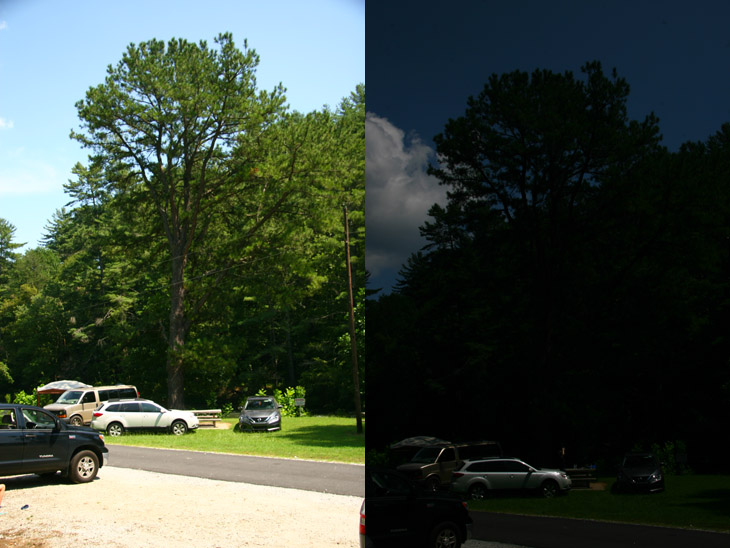
On the left is the kind of exposure that Sunny 16 should produce on a clear day, while on the right is what it did produce as totality loomed a few minutes away. The actual settings for the left side of the frame was 1/10 second at f4.5, a couple of minutes before totality, which is seven stops less light than an unobstructed sun, or 1/128th the amount of light. The darker frame on the right was actually 13 minutes earlier than the one on the left, when the sun was less covered. While standing out there, as I said, it didn’t really seem that dark.
I did a sequence of frames every minute leading up to totality, but as it closed in I went for the thinnest sliver of sun I could manage. Which wasn’t too shabby, despite some filter fudging.
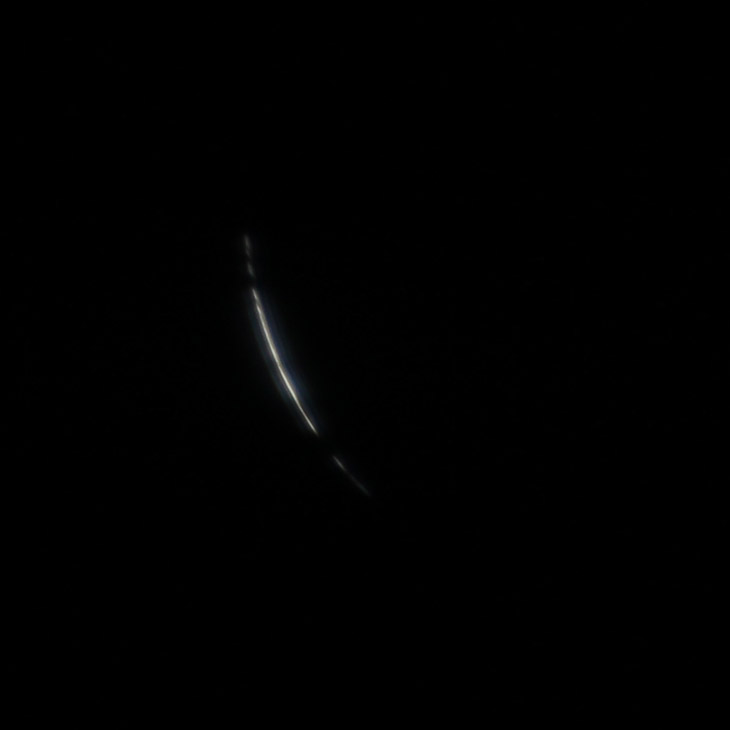
To the naked eye, this would be producing the ‘diamond ring’ effect; totality occurred a scant second later. And then I could remove the filter and shoot direct, which allowed some better detail.
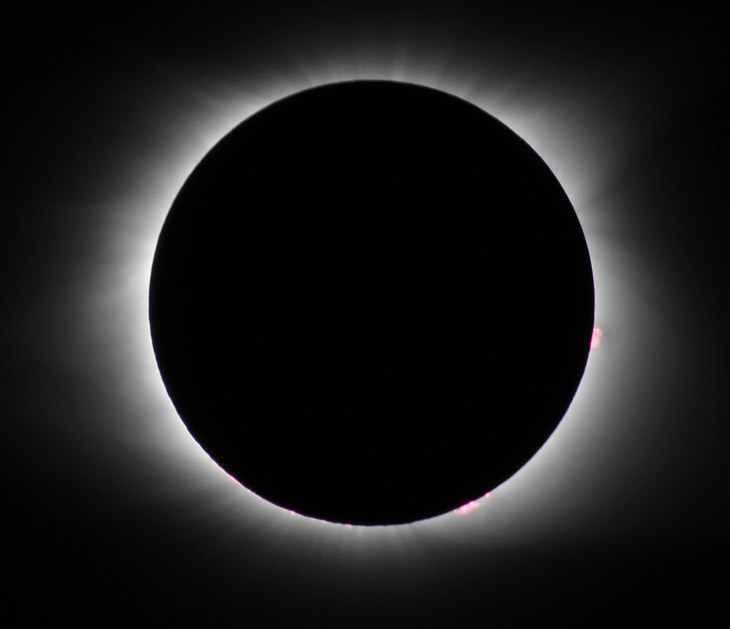
See the pinkish blobs around the lower and right edge? Those are actually solar prominences, or ‘flares’ erupting from the surface of the sun, and yes, they were just barely visible to the naked eye. I’m quite pleased.
By the way, this is 1/50th second at f11, ISO 100, which would have been enough to slightly overexpose a full moon, just to understand the brightness of the corona.
While I was playing my games, The Girlfriend was snapping away with her own camera, without the benefit of a tripod and trusting auto-exposure – not the best approach, but I was quite busy and she hadn’t asked for guidance ahead of time. One of the frames she got produced a great effect, so I have to share:
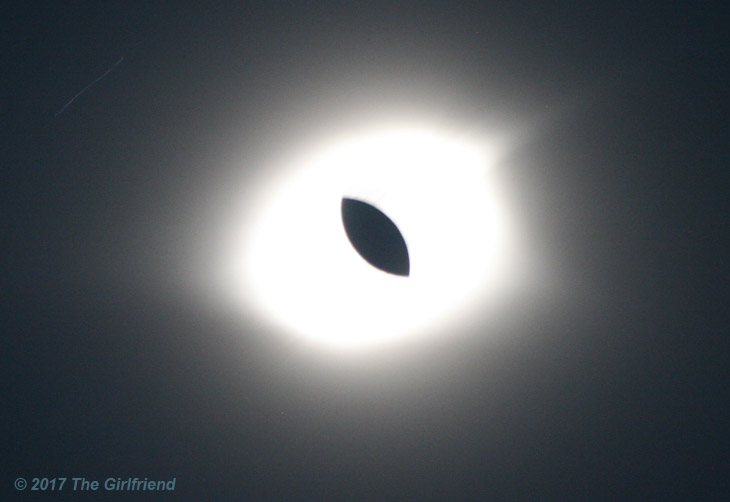
Seriously, we didn’t touch this except to crop in tighter. What happened was, she moved the camera during the exposure, and the ‘cat’s pupil’ was the section of the eclipse in the middle that didn’t get bleached out by the corona – kind of a Venn diagram of the overlap between both ends of motion. If you’re not understanding what I’m saying I won’t blame you – I’m having a hard time describing it succinctly even when I understand just how it happened. But here’s another that she got when the motion was virtually absent:
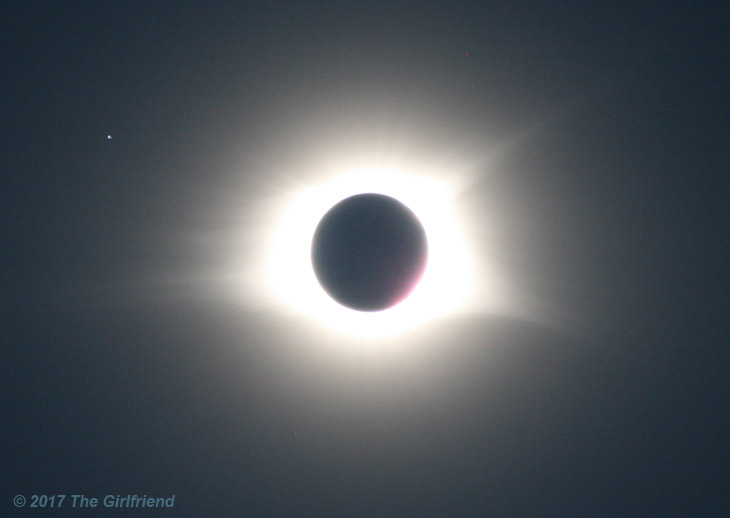
And yes, that’s a star at upper left – Regulus, to be specific. I regret now not zooming out a little when doing my own shots, because my frames were too tight to capture it. As has been said, the period of totality is very brief – 140 seconds where we were – so there’s not a lot of time to experiment and arrange tricksy shots. While the long lens was aimed at the sun where the sun had been, I was shooting other frames with a shorter lens at the surrounding landscape, trying to get both the eclipse and some kind of foreground in the same frame. I barely managed it, insofar as one frame shows a black silhouette of trees against an almost-black sky, but the light levels weren’t cooperating in this regard any more than they do for a sunny day, and to get more I would have badly overexposed the corona and obscured the blocking moon. I also realize now that, to get a decent pic of the ‘diamond ring,’ you have to shoot without any filters exactly during emergence, or the bare end of totality. Maybe next time…
The brief period of totality, along with the difficulty in seeing anything at all wrong with the sun during partial phases, leads me to question the various accounts of natives that supposedly freaked out during eclipses. You’d barely get a good froth going before the sun re-emerged, so I suspect few, if any, primitive cultures actually reacted as the European accounts relate. And bear in mind, the Europeans were the ones that engaged in witch hunts, so…
[While driving through the mountain roads to get on location, we passed a church that had offered a “special eclipse service” the day before. I’m left wondering what possible way they managed to make an astronomical event something to build a sermon on. But it couldn’t be just crass opportunism, I’m sure.]
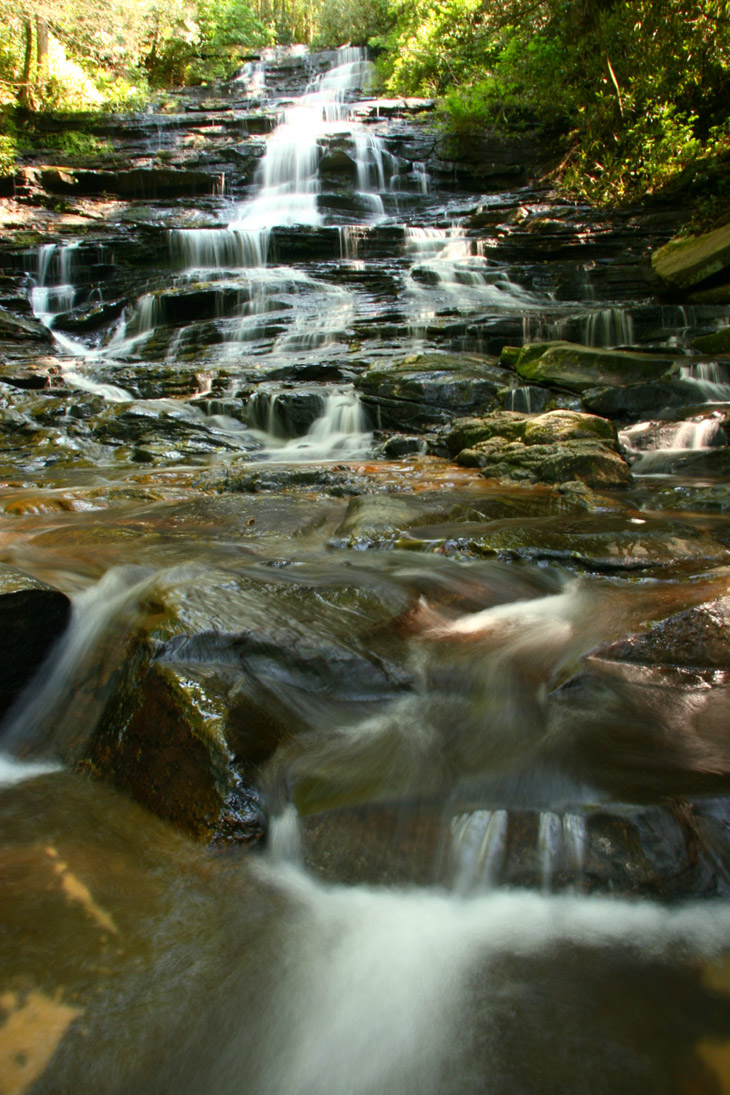
Afterward – actually, while still during the partial phase but you couldn’t tell from the light – we went only a few kilometers away to Minnehaha Falls, another easy waterfall to reach and much more dynamic than Looking Glass – I’ve done it a few times before; in fact, I have a series of seven or eight frames that I use with students to demonstrate how one should ‘work’ a subject and examine different perspectives, angles, and possibilities. Again, I was a bit limited this time around, primarily because of the eclipse – not because of the light, which actually helped, but because there were a lot more people in the region and very quickly the falls looked like a playground. It was time to start the (ridiculous) drive back, but I’ll close with another shot from The Girlfriend, capturing some dipshit playing in the water and getting into the frame of her own compositions. Some people just have no consideration…
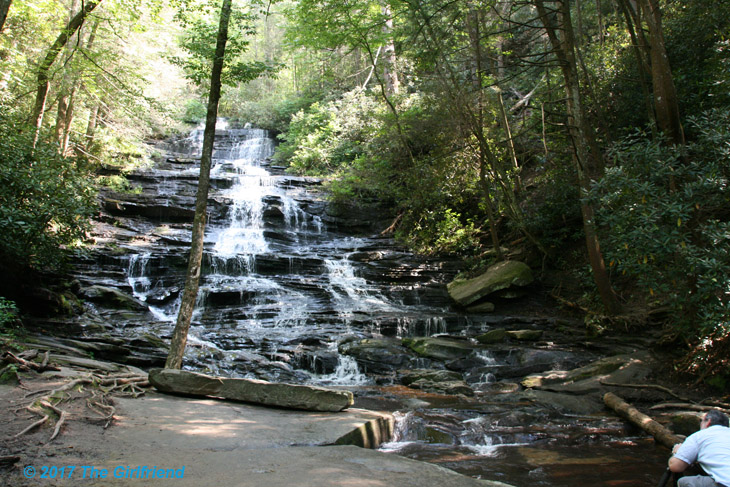





















































Nice job! No wait, you didn’t get paid. Still, I appreciate the effort you put in to this. Yes, even with the craptacular images I sent you, I get “you should really sell these.” Ok, how much would you give me for this one? Ummm, well…. And now you all know why I don’t.
I shoot images for me, if you don’t like then, I don’t care, because nobody is paying me to care. Rant over.
On an up note, the town I grew up in, Tiffin, Ohio, will be in the totality path of the 2024 solar eclipse. I may need to go “home” about then.
I have already been invited to view it from Cleveland, so we’ll probably meet up somewhere in there.
On the iffy edges of the sun, I screwed up and left on the center spot metering on instead of going to manual. Best not to tell anyone that I remembered the tripod, but forgot the mounting bracket too.
I had shot several test images with the solar filter a few days previously, and so was shooting manual during the eclipse based on those experiments, but glancing at the LCD during the latter stages, I began lengthening the exposure. I went from f14 and 1/1000 second during most of the partial phase, all the way down to 1/50 and f11 for the barest crescent shown here. I then bracketed the total phase heavily with the filter removed, but a lot of the shots didn’t come out because of camera shake, even with the tripod – at that magnification, it doesn’t take much, and I wasn’t using the remote release like I should’ve.
Next time, next time…
Very good shots y’all ! Looks like you hit it right! The GirlFriends shot is my favorite!!Way to go Susan!!